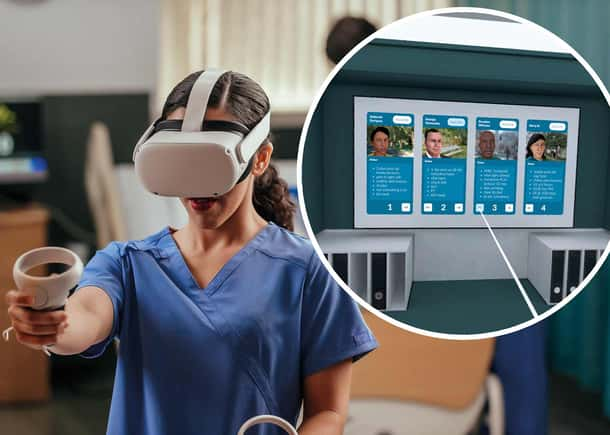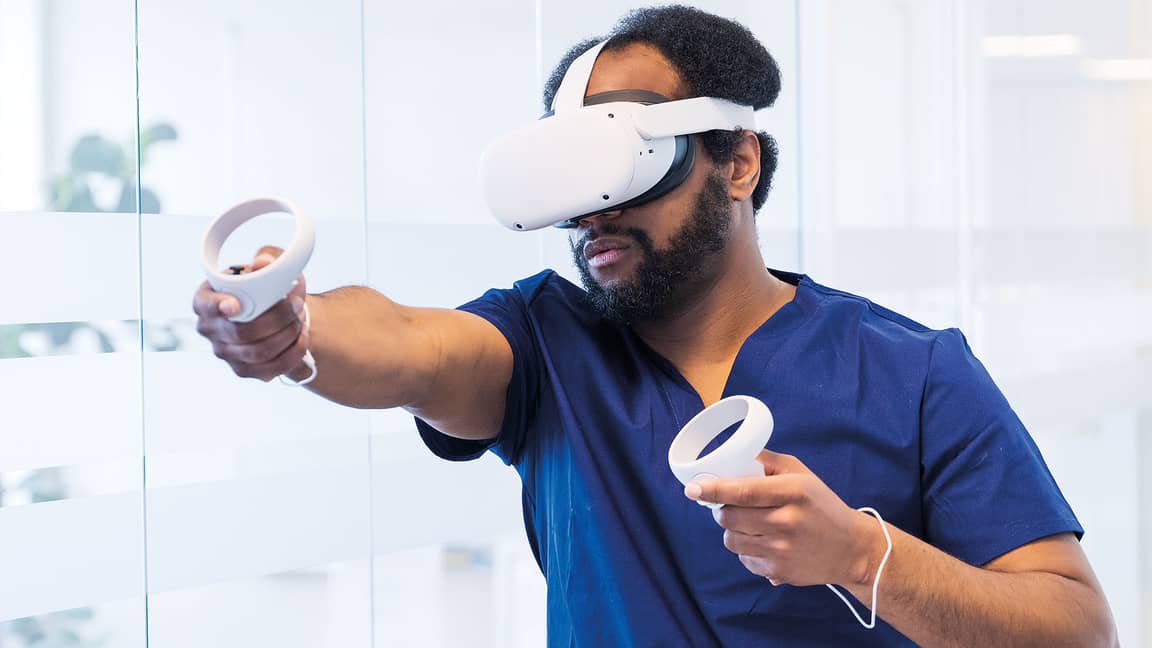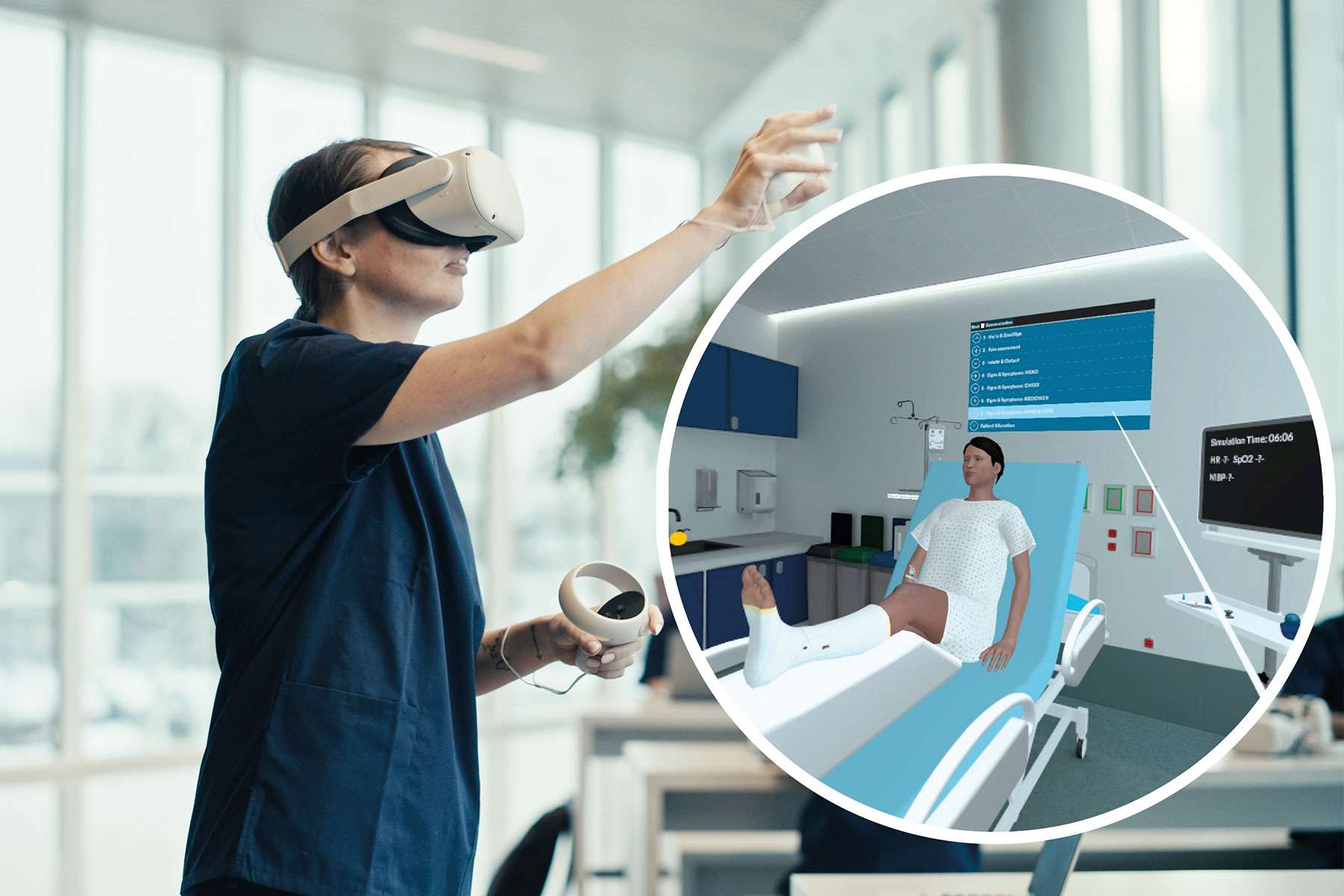3 Benefits of VR Simulation Training for Hospitals
Virtual reality simulation is a powerful training method for ensuring clinician preparedness. Here are 3 important areas where VR can help your hospital.

Virtual reality simulation is a powerful training method for ensuring clinician preparedness. Here are 3 important areas where VR can help your hospital.

If you’re in healthcare, you likely know the value of patient simulation training. Valued for its ability to provide realistic, hands-on learning experiences without posing any risk to real patients, simulation has developed a reputation as an essential training tool.
In recent years, virtual reality (VR) technology has made significant strides in various industries – and healthcare training is no exception. Many hospitals are now utilizing virtual reality simulation training to help prepare their clinicians to provide safe, effective patient care.
In this article, we discuss the benefits of using VR simulation training and explore 3 ways that it can help hospitals tackle the challenges they are facing today.
Virtual reality simulation training uses headsets to immerse learners in highly realistic patient care settings where they can care for patients the same way they would in real life. Some of the reasons that hospitals are increasingly looking to this training method include:

If you currently use traditional patient simulation, then you know the amount of time, effort, and resources that go into ensuring realism in your scenarios. And, you know that there are many patient conditions that are especially difficult or even impossible to realistically simulate with a manikin or standardized patient – such as neurologic conditions, rashes, and strokes, to name a few. With VR simulation, you can easily simulate any patient condition, in any setting – from the OR, to the ED, to a transport helicopter.1 And, you can set it up in a matter of minutes.
Just like traditional simulation training, VR offers a safe, controlled environment for learners to practice low-frequency, high-acuity emergencies under pressure – without putting patients at risk.
VR simulation training platforms immerse learners in realistic hospital environments. Depending on the platform, various features are used to achieve maximum realism. For example, vrClinicals for Nursing challenges learners to manage interruptions to care and prioritize multiple patients. The SimX platform doesn’t use drop-downs, multiple choice, or learner cue prompts – making learners interact directly with patients. And, it provides a real tactile experience: learners can pick up tools and use them for patient care.
VR simulation allows every learner to get the same training experience, ensuring that everyone has had the opportunity to train in situations that they may not have encountered yet on the hospital floor.
VR simulation can provide you with powerful reporting tools that allow you to track performance over time and facilitate effective debriefing. This can include critical actions that were and weren’t performed, along with timestamps of every action performed in the scenario.
VR simulation eliminates many of the expenses of traditional patient simulation, including equipment, setup time, and other resources. This means that adding VR simulation to an existing simulation program can amplify the amount of simulation training opportunities you can offer.
VR training allows healthcare professionals to train when it fits their schedule. This is particularly beneficial for busy providers who may find it challenging to attend traditional training programs. VR platforms can be accessed remotely, enabling learners to practice anywhere.

VR simulation training can play a key role in empowering your staff with the skills they need to transition to practice effectively.
Research estimates that only 14% of new graduate nurses demonstrate entry-level readiness for nursing residency.2 Training using VR nursing simulation scenarios has been shown to significantly improve nurses’ self-assessed competence when used as part of a nursing residency program curriculum.3
The first days of residency are challenging for new resident interns as well. “When they first start, they’re really passive, they’re not good at communicating, they’re very reticent to take on the leadership role, and their level of confidence is low,” explains Andrew Wackett, MD, and Director of the Clinical Simulation Center at the Renaissance School of Medicine at Stony Brook University.4
Andrew Wackett, MD, Director of the Clinical Simulation Center at the Renaissance School of Medicine at Stony Brook University5
In the VR environment, learners assess, diagnose, and treat patients just like they would in real life.
This skill is directly linked to more than 46% of tasks performed by entry-level nurses6 – making it imperative for a successful transition to practice.
By interacting with realistic patients in true-to-life clinical scenarios, learners can master skills in empathy, compassion, communication, cultural competence, and other essential elements of patient-centered care.
In today’s understaffed healthcare environment, this skill is more critical than ever. vrClinicals for Nursing allows learners to sharpen their skills in prioritizing patients across the ward.
This skill is coming into greater focus at many hospitals. A good example illustrating its importance is an infant cardiac arrest in the ICU. The skills that providers need in order to successfully navigate this low-frequency, high-acuity emergency go beyond just performing high-quality CPR on an infant. In the middle of this incredibly stressful and chaotic emergency, providers may also need to handle panicked, crying parents frantically asking them what they’re doing to the baby.7 This scenario can be exactly replicated using VR – so that when providers encounter it, it won’t feel like the first time.

“Improving patient safety is a team sport.”10 When providers work effectively as a team, they can make a positive impact on patient outcomes, reduce medical errors, and increase patient satisfaction.11
In a virtual reality simulation training platform like SimX, multiple participants can log in to the same scenario from anywhere. Then, they can work on treating the patient together as a team in the virtual environment just like they would in real life. These training opportunities can help them to develop a shared mental model, or “common language” – a key factor in effective teamwork.12
Research suggests that VR simulation can be just as effective for team training as traditional simulation. In one study, 120 medical and nursing students were assigned to participate in team training using either VR or traditional simulation. The study found no significant difference in their communication performance outcomes between the VR simulation and the traditional simulation groups: both groups showed significant increases in their interprofessional attitudes.13

If your hospital is like most others, you’re facing major struggles with nurse turnover. This ongoing crisis has likely made your nursing recruitment and retention strategies a top priority.
Expanding your professional development program is one strategy that’s worth focusing your efforts on.
Nurses want to grow in their careers and advance their skills.16 In fact, they report wanting to spend more than double the amount of time on growth and development activities.17 They cite the desire to provide high-quality patient care as the primary motivation for pursuing professional development.18
VR simulation can be a flexible and cost-effective option to help you increase opportunities for your nurses to refine essential patient care skills – without requiring significant increases in equipment, space, educators, and time away from patients.
When considering your nursing recruitment strategies, remember that professional development is important not just to your current nurses – but also to the potential new hires that you’re trying to attract. This means that boosting development opportunities using virtual reality simulation training may make your organization even more appealing to potential new hires.